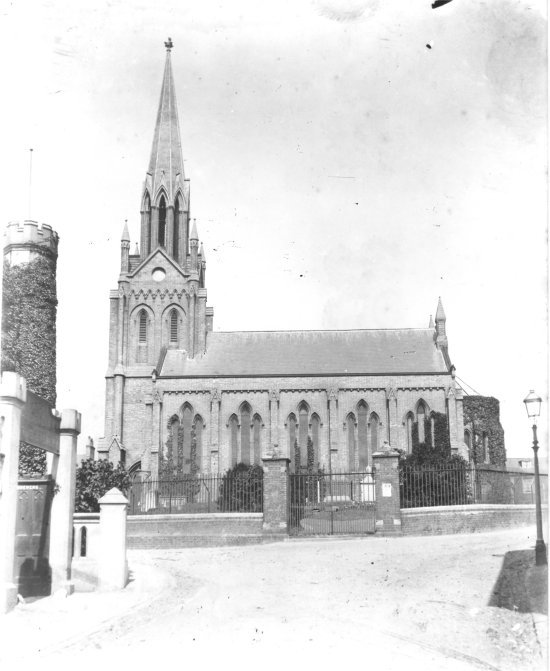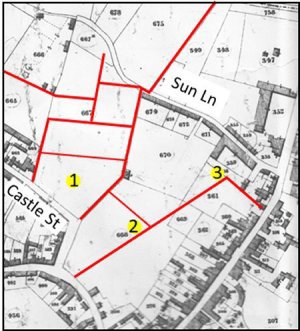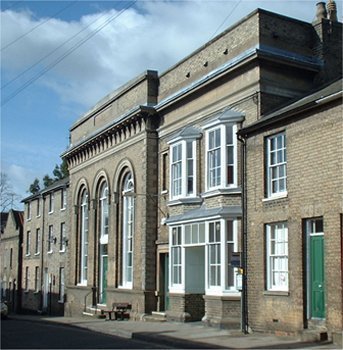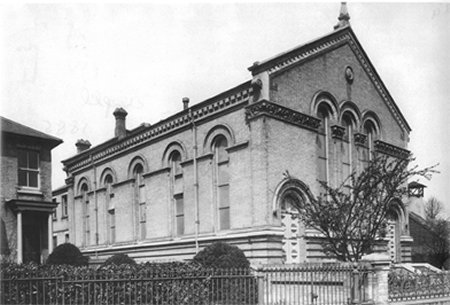Old, and Some New, Photographs of Woodbridge & Melton
St Johnís Church was built as a result of the energy of the Reverend Henry Hardinge. He became rector at St Maryís in 1839 and his preaching filled the church to overflowing. He then started the project of building a new church or Ďchapel of easeí on part of some former grazing land at the bottom of Castle Street. This land, which had been put up for sale in 1840, had previously been rented to a herdsman named Pite for grazing. Within two years £2,600 had been raised to build the church. The foundation stone was laid in June 1842 and the church was eventually consecrated in 1846.
The church originally had a tower topped with an elegant spire rising to the height of 138 feet but the spire had to be removed, in the 1970s, because iron bars used to reinforce the stonework had corroded. The remaining stumpy tower never looked right and but this was rectified when an anonymous benefactor came forward to fund a new spire which was erected in 2003.

During the 1840s there were further developments further up Castle Street. A number of new streets were laid out and they are shown here as a red overlay on the tithe map. However, the demand for houses along these streets was not as great as expected and the development was not completed until the end of the century.
Three major public buildings were built in the area. They were the St John's Church (marked 1) Woodbridge Literary and Mechanics Institute (marked 2) and the Wesleyan Chapel (marked 3).

William Martin, a writer of children's books under the pseudonym Peter Parley, spent most of his life at Woodbridge and was a friend of the Lockwoods. He suggested to William Jnr. that they should form a literary and scientific society. This lead to the foundation the Woodbridge Literary and Mechanical Institute in 1838 and William Jnr. was it first secretary.
Literary and Mechanics Institutes had sprung up all over the country to satisfy a thirst for education by both young and old. The Woodbridge Institute had started in 1835 and by 1852 a group of shareholders put up £300 to provide the Institute with a building in St Johnís Street. A further £1000, raised from £5 shares, was used to build an adjoining Lecture Hall. The latter was a large handsome building of white brick. It was let for various purposes and could accommodate 500 persons. At its zenith the Institute had about 100 members and a library of about 5000 volumes. The Lecture Hall was eventually taken over by the YMCA and in 1929 it was converted to the Roman Catholic Church of St Thomas of Canterbury.

In 1812 a soldier drummer of the Lincolnshire Regiment, who was also a Methodist local preacher, was granted permission to hold services in the Woodbridge barracks. Later, services were held in two hired rooms in the town. Then, in 1829, a chapel was built in Brook Street. It is now a private residence (No. 20) having been replaced, in 1872, by the chapel on St Johnís Street.
When the new Methodist Chapel was opened it could seat 350. The interior of the church was subdivided, in 1963, to form a school room and a smaller sanctuary. Further changes were made in 1972 and then, in 1990, a new church hall was built on the side and it was thereby possible to bring the sanctuary back to its original size.
